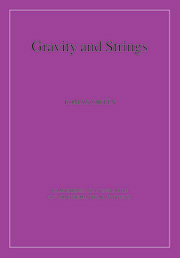Book contents
- Frontmatter
- Contents
- Preface
- Part I Introduction to gravity and supergravity
- Part II Gravitating point-particles
- Part III Gravitating extended objects of string theory
- Appendix A Lie groups, symmetric spaces, and Yang–Mills fields
- Appendix B Gamma matrices and spinors
- Appendix C n-Spheres
- Appendix D Palatini's identity
- Appendix E Conformal rescalings
- Appendix F Connections and curvature components
- Appendix G The harmonic operator on ℝ3 × S1
- References
- Index
Preface
Published online by Cambridge University Press: 20 February 2010
- Frontmatter
- Contents
- Preface
- Part I Introduction to gravity and supergravity
- Part II Gravitating point-particles
- Part III Gravitating extended objects of string theory
- Appendix A Lie groups, symmetric spaces, and Yang–Mills fields
- Appendix B Gamma matrices and spinors
- Appendix C n-Spheres
- Appendix D Palatini's identity
- Appendix E Conformal rescalings
- Appendix F Connections and curvature components
- Appendix G The harmonic operator on ℝ3 × S1
- References
- Index
Summary
String theory has lived for the past few years during a golden era in which a tremendous upsurge of new ideas, techniques, and results has proliferated. In what form they will contribute to our collective enterprise (theoretical physics) only time can tell, but it is clear that many of them have started to have an impact on closely related areas of physics and mathematics and, even if string theory does not reach its ultimate goal of becoming a theory of everything, it will have played a crucial, inspiring role.
There are many interesting things that have been learned and achieved in this field that we feel can (and perhaps should) be taught to graduate students. However, we have found that this is impossible without the introduction of many ideas, techniques, and results that are not normally taught together in standard courses on general relativity, field theory or string theory, but which have become everyday tools for researchers in this field: black holes, strings, membranes, solitons, instantons, unbroken supersymmetry, Hawking radiation . … They can, of course, be found in various textbooks and research papers, presented from various viewpoints, but not in a single reference with a consistent organization of the ideas (not to mention a consistent notation).
These are the main reasons for the existence of this book, which tries to fill this gap by covering a wide range of topics related, in one way or another, to what we may call semiclassical string gravity.
- Type
- Chapter
- Information
- Gravity and Strings , pp. xix - xxPublisher: Cambridge University PressPrint publication year: 2004

